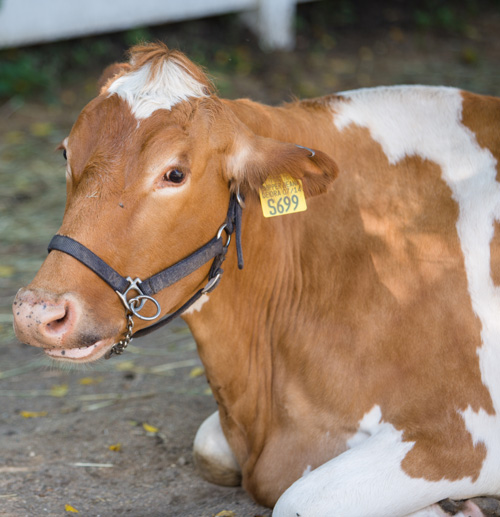Photo by Kmiecik Imagery
Guernsey Cow
Bos taurus taurus guernsey
Description
Dairy cows are noted for their angular body shapes. The great majority of the energy they gain from their food goes towards milk production, meaning that little fat stays on their bodies. Guernsey cows are usually light brown in color with clearly defined white markings.
Size
Mature Guernseys weigh approximately 1150 pounds.
Adaptations
Cattle are ruminants, or animals with four-chambered stomachs. They begin the digestive process by chewing their food just a small amount. This partially chewed food is swallowed and enters the first chamber of the stomach (rumen). After cattle finish eating, they regurgitate the food back into the mouth, where it is more thoroughly chewed. This is called “chewing the cud”. The food then passes through the remaining three parts of the stomach for complete digestion.
Diet
A cow’s diet consists of high-quality grain and hay. Dairy cows are typically fed much more than beef cows due to the high amounts of energy that they need to produce milk.
Reproduction
A dairy cow has a gestation of 9 months. Newborn calves nurse once from their mother to receive the necessary colostrum (first milk) for good health. They are then removed to calf raising quarters. After calving, cows are usually milked for 305 days and then allowed to “dry up” for 60 days to prepare for their next calf.
Shelter and Space Needs
Cattle have a reasonably high tolerance for cold weather, although they do need to be provided with shelter from extreme conditions. Cosley Zoo’s dairy cow has a stall inside the barn where she spends the night and an outdoor yard that she shares with the beef cow during the day.
Life Expectancy
Cattle have the potential to live 10-12 years.
Relationship With Man
A Guernsey’s milk is very high in butterfat and can be used to manufacture butter, cheese, and ice cream. Because of milk’s composition, it is an easily digestible source of high-quality protein, minerals and vitamins.
Fun Facts
- The milking machine was invented in 1894. Before its existence, farmers could milk about 6 cows per hour. Now with milking machines, they can milk 100 cows per hour!
- On an average day, a dairy cow will drink the equivalent of a bathtub full of water.
- Cows spend up to 8 hours a day chewing their cud!






